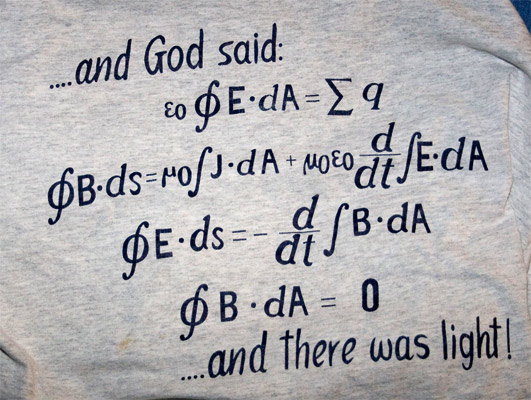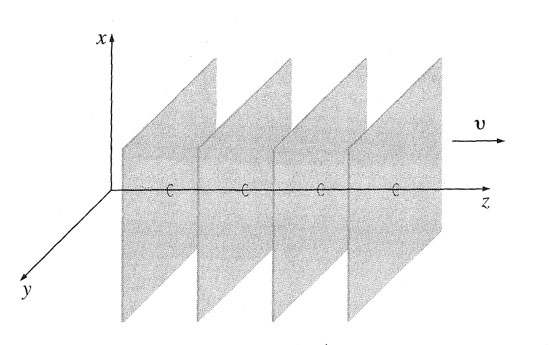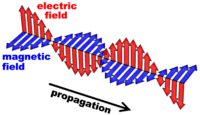Maxwell's equations in matter

For linear media, we have... $$\myv{D}=\epsilon\myv{E}\ \hbox{ and }\ \myv{H}=\frac{1}{\mu}\myv{B}.$$
In terms of free charges and free currents, these are the four "Maxwell equations": $$\myv{\nabla}\cdot\myv{D} = \rho_f$$ $$\myv{\nabla}\cdot\myv{B} = 0$$ $$\myv{\nabla}\times\myv{E} = -\frac{\del \myv{B}}{\del t}$$ $$\myv{\nabla}\times \myv{H} = \myv{J}_f+\frac{\del \myv{D}}{\del t}$$
Now, let's think about these equations in vacuum:
- no free charge $\rho_f=0$,
- no free current ($\myv{J}_f=0$),
- $\epsilon\to \epsilon_0$ and $\mu\to\mu_0$.
$$\myv{\nabla}\cdot\myv{E} = 0$$
$$\myv{\nabla}\cdot\myv{B} = 0$$
$$\myv{\nabla}\times\myv{E} = -\frac{\del \myv{B}}{\del t}$$
$$\myv{\nabla}\times \myv{B} = \mu_0\epsilon_0\frac{\del \myv{E}}{\del t}$$
Taking the curl of the 3rd equation, we can use the identity (number 11 inside the cover of Griffith's book) $$\myv{\nabla} \times ( \myv{\nabla} \times \myv{A}) = \myv{\nabla}\(\myv{\nabla}\cdot\myv{A}\) - \nabla^2\myv{A}.$$
to re-write that $\myv\grad\times\myv E$ equation... $$\begineq \myv{\nabla}\times \(\myv{\nabla} \times\myv{E}\) &= \myv{\nabla} \times \(-\frac{\del \myv B}{\del t}\)\\ \myv{\nabla}\(\myv{\nabla}\cdot\myv{E}\) - \nabla^2\myv{E} &= -\frac{\del}{\del t}\(\myv{\nabla} \times \myv B\) \\ - \nabla^2\myv{E} &= -\frac{\del}{\del t}\( \mu_0\epsilon_0\frac{\del \myv{E}}{\del t} \) \endeq$$
This is really three equations for each of the components of $\myv E$, like $$\left[\frac{\del^2}{\del x^2} +\frac{\del^2}{\del y^2} +\frac{\del^2}{\del z^2}\right]E_x(x,y,z,t)=\mu_0\epsilon_0\frac{\del^2}{\del t^2}E_x(x,y,z,t).$$
So, $E_x$, $E_y$, and $E_z$ each obey an equation which actually turns out to be a wave equation: $$ \nabla^2 u -\frac{1}{v^2}\frac{\del^2 u}{\del t^2}=0,$$
Where the constant $v$ is... $$v\equiv \frac{1}{\sqrt{\mu_0\epsilon_0}}.$$
Figure out what $k$ has to be (in terms of $\omega$ and $v$) in order for this to be a solution to the wave equation: $$u(x,y,z,t) = \cos(kz-\omega t).$$ ...and what direction is this solution moving in? [WA picture of $u(x,y,z,t=0)$ and at $t=0.5$ with $v=1$, $\omega=1$].
What is happening in the $x$- and $y$-directions?
Here's a conceptual picture of the function $\cos(kz-\omega t)$. The planes connect all the points in space at one instant in time where $u=1$ (the peak value of the sinusoidally oscillating cosine function). These planes move in the $z$-direction with speed $v$. This is a called a 'plane wave' solution.

Come up with a $u(x,y,z,t)$ that is moving in the $-\uv y$ direction.
We could write these last two solutions as...$$u=\cos(k\uv z\cdot \myv r - \omega t)$$ and $$u=\cos(k(-\uv y)\cdot \myv r - \omega t)$$ with $k=\omega/v$ in each case.
Come up with a $u(x,y,z,t)$ that is moving in the direction which is half-way between $\uv x$ + $\uv y$.
Plane wave solution
A very general solution to the wave equation for any one of the components of the electric field, is a plane wave solution travelling with speed $v$ in the direction of $\myv k$: $$ u=C\cos\left(\myv k \cdot \myv r+\omega t + \delta\right).$$ The magnitude of the 'wave vector' $\myv k$ is (in linear materials): $$|\myv k| \equiv k =\frac{\omega}{v}=\sqrt{\mu\epsilon} \omega$$
The speed in vacuum is (in the SI units we've been using, this should come out in m/s)... $$v_0 = \frac{1}{\sqrt{\mu_0\epsilon_0}}=\frac{1}{\sqrt{4\pi\times 10^{-7}\cdot8.85\times 10^{-12}}}. $$
$$= 3 \times 10^8\hbox{m/sec}= c\ !!!$$ Remember where these constants $\epsilon_0$ and $\mu_0$ came from... (not experiments with light!)
In optics, the index of refraction was defined as the speed of light in vacuum divided by the effective speed of light in a medium: $$n=c/v = \frac{\sqrt{\mu_0\epsilon_0}}{\sqrt{\mu\epsilon}}.$$ (For most insulators, $\mu\approx \mu_0$...)
The argument of the cosine function is in radians, so the 'angular frequency' $\omega$ apparently has units of [radians/sec]. Since there are $2\pi$ radians in one cycle, the frequency, $f$, of the wave (which has units of [cycles/sec]) is: $$f=\frac{\omega}{2\pi}.$$
The wave vector has units of [radians/meter]. The wavelength, $\lambda$, of a wave can be thought of as having units of [meters/cycle], so $$\frac{1}{\lambda}=\frac{k}{2\pi}.$$
The relation above between $k$ and $\omega$ becomes $$v=\frac{\omega}{k}=\frac{2\pi f}{2\pi/\lambda}=f\lambda.$$
Writing the plane wave as a complex wave
Euler says: $$e^{i\theta}=\cos\theta + i\sin\theta,$$ $$\Rightarrow \cos\theta = Re[e^{i\theta}].$$
Re-writing our general solution in terms of complex exponentials... $$\begineq u&=C\cos\left(\myv k \cdot \myv r+\omega t + \delta\right)\\ &= Re\left[Ce^{i\delta}e^{i\myv k \cdot \myv r-i\omega t}\right]=Re\left[Ze^{i\myv k \cdot \myv r-i\omega t}\right] \endeq $$ where $Z=Ce^{i\delta}$ is a complex constant number.
This is the equation for just one of the Cartesian components of $\myv E$. We can write all three amplitudes together as... $$\myv E (\myv r, t) = Re\left[\myv{\mathcal E} e^{i\myv k \cdot \myv r -i\omega t}\right]$$ where $\myv{\mathcal E}$ is constant vector with 3 complex components.
If we had started with $\myv\grad\times(\myv\grad\times\myv B)$ instead, we would get identical wave equations for $\myv B$, and so a very general solution for $\myv B(x,y,z,t)$ is... $$\myv B(\myv r, t) = Re\left[\myv{\mathcal B} e^{i\myv k \cdot \myv r -i\omega t}\right].$$ Where $\myv{\mathcal B}$ comprises 3 complex constants.
Relations between $\myv E$, $\myv B$ and $\myv k$
If there's no free charge around, the first of the 4 Maxwell equations (applied to our plane wave solution $\myv E(\myv r, t))$: $$0=\myv \nabla \cdot \myv E= \myv k \cdot \myv{\mathcal E} e^{i\myv k \cdot \myv r -i\omega t}\Rightarrow \myv k \cdot \myv{\mathcal E} = 0$$ In other words, $\myv k \perp \myv E$.
Similarly, $\myv \grad \cdot \myv B=0 \Rightarrow \myv k \perp \myv B$.
$\Rightarrow$ both $\myv{\mathcal E}$ and $\myv{\mathcal B}$ are perpendicular to $\myv k$: The oscillation is happening at right angles to the propagation. This is called a transverse wave.
Faraday's law $\myv{\nabla}\times\myv{E} = -\frac{\del \myv{B}}{\del t}$ equation leads to the relationship: $$\myv k \times \myv{\mathcal E}= \omega \myv{\mathcal B} $$
- $\myv k$, $\myv{\mathcal E}$, and $\myv{\mathcal B}$ are mutually perpendicular,
- $\uv{\mathcal E}$ is the direction of polarization of the wave.
- If $\myv k$ is real, then $\myv{\mathcal E}$ and $\myv{\mathcal B}$ have the same phase $\Rightarrow$ they are 'in phase'.
- $|\myv {\cal B}|={\cal B}=(k/\omega){\cal E}=(1/v){\cal E}.$
